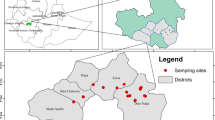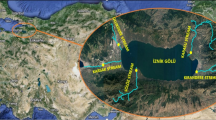Abstract
Burullus lake is one of the coastal lakes in northern Egypt. Burullus lake is connected to seven drains through its western, eastern, and southern shores. The discharge of untreated wastewater (domestic, industrial, and agricultural) from these drains caused degradation for the water quality of the lake. Therefore, it is needed to develop a methodology to monitor water quality parameters at a low cost. This study is a trial to estimate water quality parameters from remote sensing data (reflectance data) by developing statistical regression models. Sentinel-2 reflectance data are compared to field measurements. The field measurements include transparency (SDT), chlorophyll-a concentration (Chl-a), total nitrogen (TN), total phosphorus (TP), and salinity. The coefficient of determination (R2) and normalized root mean square error (NRMSE) are calculated to evaluate the goodness of fit between field measurements and reflectance values. The results show that the optimum bands and bands ratios to estimate SDT, Chl-a, TN, TP, and Salinity are B6/B7, B7/B8, B8A, B8/B3, and B3/B8, respectively. The developed regression model is acceptable to be used for detecting water parameters and the produced R2 and NRMSE are within the range from 0.52 to 0.83 and from 0.12 to 0.34, respectively. The distribution maps of water quality parameters were built using the regression equations by writing these equations in the raster calculator as raster calculation expression. The results of this study show that both optical and non-optical water quality parameters are reasonably correlated with Sentinel-2 reflectance data as a low-cost data source.






Similar content being viewed by others
REFERENCES
Allen, S., Grimshaw, H., Parkinson, J., Quarmby, C., and Robberts, J., Chemical analysis, In Methods in Plant Ecology, Moore, D. and Chapman, S.B., Eds., Oxford: Blackwell Sci. Publ., 1986, 2nd edition, pp. 285−344.
Arenz, R., Lewis, W., and Saunders, J., Determination of chlorophyll and dissolved organic carbon from reflectance data for Colorado reservoirs, Int. J. Remote Sensing, 1996, vol. 17, pp. 1547−1566.
Baban, S., Environmental monitoring of estuaries; estimating and mapping various environmental indicators in Breydon Water Estuary, U.K., using Landsat TM imagery, Estuarine, Coastal Shelf Sci., 1997, vol. 44, pp. 589−598.
Bagheri, S. and Dios, R., Chlorophyll-a estimation in New Jersey’s coastal waters using Thematic Mapper data, Int. J. Remote Sensing, 1990, vol. 11, pp. 289−299.
Bonansea, M., Rodriguez, M., Pinotti, L., and Ferrero, S., Using multi-temporal Landsat imagery and linear mixed models for assessing water quality parameters in Río Tercero reservoir (Argentina), Remote Sensing Environ., 2015, vol. 158, pp. 28−41.
Braga, C. and Setzer, A., Water quality assessment with simultaneous Landsat-5 TM data Guanabara bay, Rio de Janeiro, Brazil, Remote Sensing Environ., 1993, vol. 45, pp. 95−106.
Dewidar, K. and Khedr, A., Water quality assessment with simultaneous Landsat-5 TM at Manzala Lake, Egypt, Hydrobiologia, 2001, vol. 457, pp. 49−58.
Durand, D. and Cauneau, F., Towards a new method for shallow-water monitoring using remote sensing, in Proc. Future Trends in Remote Sensing EARSeL Conf., Balkema, A.A., Ed., Rotterdam, The Netherlands, 1998, pp. 355−359.
El-Asmar, H., Hereher, M., and El Kafrawy, S., Surface area change detection of the Burullus Lagoon, North of the Nile Delta, Egypt, using water indices: A remote sensing approach, The Egyptian J. Remote Sensing Space Sci., 2013, vol. 16, pp. 119−123.
Erkkila, A. and Kalliola, R., Patterns and dynamics of coastal waters in multi-temporal satellite images: support to water quality monitoring in the Archipelago Sea, Finland. Estuarine, Coastal Shelf Sci., 2004, vol. 60, pp. 165−177.
Frihy, O. and Dewidar, K., Influence of shoreline erosion and accretion on texture and heavy mineral compositions of beach sands of the Burullus coast, north-central Nile delta, Egypt, Int. J. Marine Geo., 1993, vol. 114, pp. 91−104.
Giardino, C., Pepe, M., Brivio, P., Ghezzi, P., and Zilioli, E., Detecting chlorophyll, Secchi disk depth and surface temperature in a sub-alpine lake using Landsat imagery, Sci. Total Environ., 2001, vol. 268, nos. 1−3, pp. 19−29.
Hossen, H. and Negm, A., Change detection in the water bodies of Burullus Lake, Northern Nile Delta, Egypt, using RS/GIS, Procedia Eng., 2016, vol. 154, pp. 951−958.
Huang, C., Zhang, Z., Yang, L., Luylie, B., and Homer, C., MRLC 2000. Image preprocessing procedure. USGS White paper. Available from http://www.landcover.usgs.gob/pdf/image_preprocessing.pdf. [Accessed January 30, 2014]
Kahru, M., Horstmann, U., and Rud, O., Satellite detection of increased cyanobacteria blooms in the Baltic Sea: natural fluctuation or ecosystem change, Ambio, 1994, vol. 23, pp. 469−472.
Kahru, M. and Mitchell, B., Empirical chlorophyll algorithm and preliminary SeaWiFS validation for the California Current, Int. J. Remote Sensing, 1999, vol. 20, pp. 3423−3429.
Khedr, A. and Lovett-Doust, J., Determinants of floristic diversity and vegetation composition on the islands of Lake Burullus, Egypt, Applied Vegetation Sci., 2000, vol. 3, pp. 147−156.
Khorram, S. and Cheshire, H., Remote sensing of water quality in the Neuse river estuary, North Carolina, Photogramm. Eng. Remote Sensing, 1985, vol. 51, pp. 329−341.
Matthews, M., A current review of empirical procedures of remote sensing in inland and near-coastal transitional waters, Int. J. Remote Sensing, 2011, vol. 32, no. 21, pp. 6855−6899.
Mikkelsen, O., Variation in the projected surface area of suspended particles: Implication for remote sensing assessment of TSM, Remote Sensing Environ., 2002, vol. 79, pp. 23–29.
Nanu, L. and Robertson, C., Estimating suspended sediment concentrations from spectral reflectance data, Int. J. Remote Sensing, 1990, vol. 11, pp. 913−920.
Nguyen, P., Koedsin, W., McNeil, D., and Van, T., Remote sensing techniques to predict salinity intrusion: application for a data-poor area of the coastal Mekong Delta, Vietnam, Int. J. Remote Sensing, 2018, vol. 39, pp. 6676−6691.
Odermatt, D., Gitelson, A., Brando, V., and Schaepman, M., Review of constituent retrieval in optically deep and complex waters from satellite imagery, Remote Sensing Environ., 2012, vol. 118, pp. 116−126.
Rembold, F., Carnicelli, S., Nori, M., and Ferrari, G., Use of aerial photographs and Landsat TM imagery and multidisciplinary field survey for land-cover change analysis in the lakes region (Ethiopia), Int. J. Applied Earth Observation Geoinformation, 2000, vol. 2, pp. 181−189.
Richard, G., Lathrop, J., and Thomas, M., Use of thematic mapper data to assess water quality in Green Bay and central Lake Michigan, Photogram. Eng. Remote Sensing, 1986, vol. 52, pp. 671−680.
Semovski, S., Dowell, M., Hapter, R., Szczucka, J., Beszczynska Moller, A., and Darecki, M., The integration of remotely sensed, sea truth and modelled data in the investigation of mesoscale features in the Baltic coastal phytoplankton field, Int. J. Remote Sensing, 1999, vol. 20, pp. 1265−1287.
Sriwongsitanon, N., Surakit, K., and Thianpopirug, S., Influence of atmospheric correction and number of sampling points on the accuracy of water clarity assessment using remote sensing application, J. Hydrol., 2011, vol. 401, nos. 3−4, pp. 203−220.
Swift, C. and Mcintosh, R., Considerations for Microwave Remote Sensing of Ocean-Surface Salinity, IEEE Transactions Geosci. Remote Sensing, GE-21, 1983, pp. 480−491.
Tassan, S., An improved in-water algorithm for the determination of chlorophyll and suspended sediment concentration from Thematic Mapper data in coastal waters, Int. J. Remote Sensing, 1993, vol. 14, pp. 1221−1229.
Trivero, P., Borasi, M., Biamino, W., Cavagnero, M., Rinaudo, C., and Bonansea, M., River pollution remediation monitored by optical and infrared high-resolution satellite images, Environ. Monitoring Assessment, 2013, vol. 185, no. 9, pp. 7647−7658.
Verdin, J., Monitoring water quality conditions in a large western reservoir with Landsat Imagery, Photogramm. Eng. Remote Sensing, 1985, vol. 51, pp. 343−353.
Yacobi, Y., Moses, W., Kaganovsky, S., Sulimani, B., Leavitt, B., and Gitelson, A., NIR-red reflectance-based algorithms for chlorophyll-a estimation in mesotrophic inland and coastal waters: Lake Kinneret case study, Water Res., 2011, vol. 45, pp. 2428−2436
ACKNOWLEDGMENTS
The first author would like to thank the Egyptian Ministry of Higher Education (MoHE) for granting him the Post-Doctoral Scholarship. Also, thanks and gratitude for Tokyo Institute of Technology for their support and for offering the tools needed for this research. Also, thanks and gratitude for the Academy of Scientific Research and Technology (ASRT) of Egypt and the Italian National Research Council (CNR) in the framework of the bilateral CNR-ASRT project for their technical support.
Funding
The Egyptian Ministry of Higher Education (MoHE) has awarded a Postdoctoral Scholarship for the corresponding author to carry out this study. The corresponding author was hosted by Tokyo Institute of Technology as a visiting fellow, providing support and tools for this research.
Author information
Authors and Affiliations
Contributions
Hickmat Hossen (first author) is the author of the main idea of this paper and who obtained water quality data. Wael Mahmod (second author) participated in developing statistical models and reviewing the research. Abdelazim Negm (third author) is the author of the idea of using the Sentinel-2 satellite image and also contributed to the review of the research results. Takashi Nakamura (fourth author) is the author of the idea of creating the water quality distribution maps by written the regression equations as a raster calculator expressions in a raster calculator and also contributed to the review of the research results. All authors read and approved the final manuscript.
Corresponding author
Ethics declarations
CONFLICT OF INTEREST
The authors declare that they have no conflicts of interest.
AVAILABILITY OF DATA AND MATERIALS
All data generated or analysed during this study are included in this published article.
Rights and permissions
About this article
Cite this article
Hossen, H., Mahmod, W.E., Negm, A. et al. Assessing Water Quality Parameters in Burullus Lake Using Sentinel-2 Satellite Images. Water Resour 49, 321–331 (2022). https://doi.org/10.1134/S0097807822020087
Received:
Revised:
Accepted:
Published:
Issue Date:
DOI: https://doi.org/10.1134/S0097807822020087




